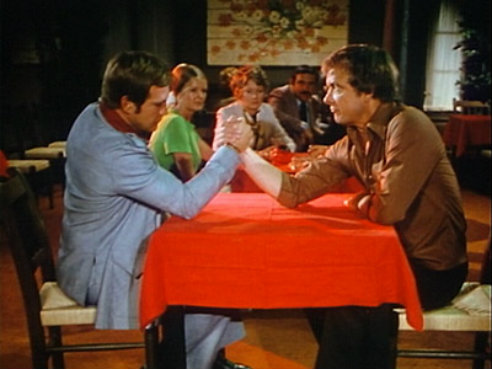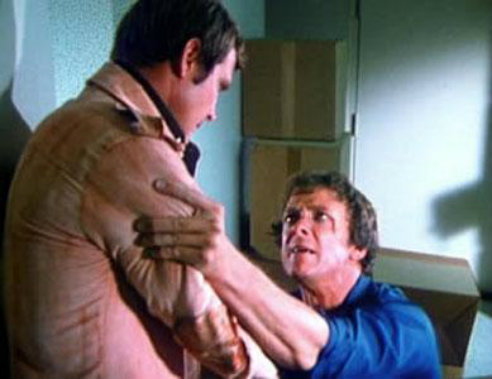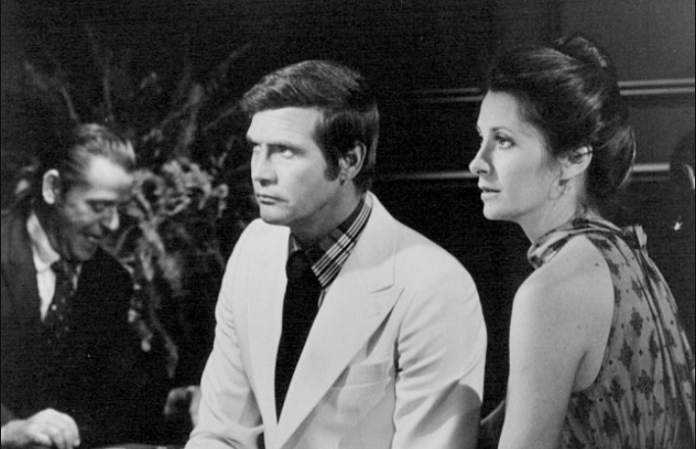The Six Million Dollar Man
Season 2, Episode 5: “The Seven Million Dollar Man”
Original airdate: Nov. 1, 1974
(Editor’s note: We decided to watch a different episode of The Six Million Dollar Man after our planned episode was taken off YouTube. That’s what you get for relying on YouTube yourself. –CB)
Nirajan: In our previous discussion about The Green Hornet, we explored the possibilities and limitations of television when it comes to portraying second-tier superheroes.
The Six Million Dollar Man and the character of Steve Austin expand on this concept, as Steve Austin doesn’t fit the conventional superhero mold.
While there is an origin story and genetically enhanced abilities, you won’t find a distinctive costume or a prominent alter ego here.
However, Steve Austin embodies the type of superhero that television frequently showcases for various reasons.
If acquiring the rights or filming high-octane action sequences for a well-known comic book character proves too costly, one can opt for a loose adaptation of a popular novel.
When iconic comic book figures like Batman or Superman appear too unrelatable, or their adversaries seem overly cartoonish, there’s always the option to craft a more relatable TV-style hero who battles “ordinary” criminals.
Although we may not immediately classify characters like Steve Austin, the Bionic Woman, or Chuck Bartowski as traditional superheroes, the distinctions between these characters and the more familiar superheroes are not overly pronounced.

“The Seven Million Dollar Man” introduces a plot that’s quite common in superhero narratives, involving the temporary transfer of a hero’s abilities to another character.
The Six Million Dollar Man didn’t shy away from exploring this concept on multiple occasions.
The backdoor pilot for The Bionic Woman follows a similar pattern, where someone on the brink of death receives bionics, and Steve has to collaborate with them to navigate this new reality.
While Jaime Summers’ experience had a more favorable outcome, this episode introduces Barney Miller as a bionic guest star, and he’s somewhat unpleasant.
His intentions revolve around using his newfound abilities for personal gain and potentially nefarious purposes, a stark contrast to the exceptionally virtuous Steve.
Despite the initial shock of discovering that Oscar and his team concealed the existence of another bionic individual, Steve and Barney eventually find common ground. They bond over the unique experiences that only they (for now) comprehend.
However, as is often the case in such situations, Barney becomes problematic, prompting Steve to teach him the responsibilities that come with being a cyborg, along with the principle of “with great power comes great responsibility.”
From a makeshift superhero perspective, this storyline is acceptable, if somewhat typical. Steve embodies the archetypal goody-two-shoes hero, which might not be to everyone’s liking, but he fits well within the procedural framework that primarily focuses on showcasing his mechanical abilities, albeit at a deliberate pace.
The opening scene suggests that he has come a long way since his accident, mainly in terms of his emotional state, as he has moved past the anger, fear, and confusion that accompanied his transformation into a bionic individual.
While it’s essential to consider the age of special effects, I couldn’t help but notice that the slow-motion action sequences unintentionally reflect the show’s overall sluggish pacing. This particular episode spans nearly 50 minutes but feels more like 90.
Steve’s fights, as well as his thought and speech patterns, come across as ponderous, which unfortunately hampers the storytelling.
However, it’s worth noting that this is the first show in our roundtable discussions with an official one-hour duration, which raises the question of whether a shorter runtime might be more suitable.
Also Read: Roundtable Review: Get Smart, “Too Many Chiefs” and “Kisses for KAOS”
Sidant: The question “What if?” holds immense power within the realm of fiction. When adhering closely to reality, these “what-ifs” serve as tools to gauge a character’s hopes, aspirations, and actions on a spectrum ranging from optimism to pessimism.
In the world of genres, especially within the history of comic books, “what-ifs” are embraced wholeheartedly. Comic book lore is teeming with alternate scenarios that stem from a single, profound alteration in a comic’s origin, such as “What if Superman had crash-landed in rural Russia instead of rural America?”

These imaginative departures are skillfully woven into entirely new narratives that establish metatextual connections with the original story.
In the annals of television history, the contrast between Barney Miller and Steve Austin struck me as bearing a striking resemblance to the conflict between Buffy Summers and Faith Lehane in Buffy the Vampire Slayer (and, to some extent, in Angel).
The similarities between Faith and Barney are almost uncanny. Both characters possess the very same powers as their heroic counterparts (Faith is a Slayer, while Barney is enhanced bionically), yet they also harbor distinct deviations in their backgrounds.
Barney distinctly mentions that he willingly consented to the surgical procedures that bestowed him with bionic abilities, in stark contrast to Steve, who had no say in the matter, given his near-death condition when he was saved.
Similarly, it becomes evident throughout Faith’s character arc in Buffy Season Three that her upbringing was notably different from Buffy’s, which contributed to her edgier demeanor compared to the slightly more well-adjusted blonde Slayer. These distinctions are essentially the only disparities between the main characters and their darker “what-if” counterparts.
Buffy and Faith stand on relatively equal footing since their powers stem from the same source, and there’s a humorous touch of competition when Barney mentions that he ended up costing a million dollars more than Steve for his reconstruction.
Even the character arcs they navigate share resemblances; toward the conclusion of “The Seven Million Dollar Man,” Barney’s plea for Steve to end his life echoes Faith’s sentiments directed at Angel in the Angel episode “Five by Five.”
It’s the vulnerability experienced after a fall from pride that imbues these redemption narratives with their compelling depth.
Shifting our focus away from that subject, I concur regarding the rather excessive use of slow-motion in the action sequences.
It felt like an overt attempt to compromise the excitement and visceral nature of the action scenes while also serving as a means to prolong the runtime to meet the 50-minute mark.
However, the underlying premise, which later serves as the foundation for the spin-off The Bionic Woman, remains solid and continues to resonate even in contemporary times.
The concept of biotechnology is simultaneously as old as the inception of science fiction itself and as fresh and relevant as today’s developments in science and technology.
This episode introduces a hint of ethical consideration, particularly since Barney appears to have come after Steve. Should Steve have been merely a one-time experiment, a long-term subject to be closely monitored for years?
Did the scientific team push the boundaries in their efforts to save Barney’s life? I’m curious to see if the show delves deeper into this aspect of its premise.
Regrettably, not enough science fiction television these days addresses ethical concerns with the diligence they deserve.
Muskan: It’s intriguing that you’ve raised the ethical concerns surrounding the transformation of these men into multi-million dollar bionic individuals.
In the initial segments of the episode before the revelation of Barney Miller’s bionic nature, it appears that the team behind Steve was conscientiously guiding Barney through the transition process.
They seemed to acknowledge that because Barney willingly chose to undergo this transformation, he might, in theory, be accepting of his new identity.
Nonetheless, they still took the necessary psychiatric precautions to ensure he could cope with the reality of becoming a human weapon. Clearly, this approach didn’t quite yield the expected results.
It’s worth noting that Steve Austin was able to offer Barney some assistance toward the end, even though it may have come too late to make a significant difference.
This raises questions about whether Barney might have taken a different path, one that wasn’t as self-absorbed or destructive with his newfound abilities.
The episode doesn’t provide a definitive answer, but it introduces enough doubt about the decision-making process of the team overseeing Steve and their handling of these experiments.
The way Steve reacts to their deception and their premature deployment of Barney on a mission raises concerns about whether Steve’s transformation was an exception that shouldn’t be replicated, regardless of how valuable he is to the government.
Alternatively, it could also suggest that Barney Miller was the anomaly, unable to adapt to his altered identity. The episode leaves room for these questions and doubts, adding complexity to the ethical dimension of their transformations.
All in all, I must say this has been my favorite episode among those we’ve discussed so far. While the excessive use of slow motion did bother me, I think it was mainly due to its frequent use throughout the episode.
If they had employed it sparingly, perhaps in just one key scene (like when Steve realizes the extent of Barney’s abilities), I don’t think it would have been as bothersome.
What I truly relished were the subtle character moments the show afforded almost every pair of individuals within the group.
Even without having watched a single episode of The Six Million Dollar Man before, I could discern some of the history and dynamics within each relationship.
The exchanges between Steve and the nurse, in particular, were quite touching. It was evident how hurt both of them were by what seemed like a betrayal after all they had been through together.
Every interaction carried a depth of emotion and backstory, even if Lee Majors’ facial expressions didn’t always convey that. Additionally, I appreciated hearing the iconic theme song associated with the show.
It’s one of the most renowned intros in television history, and it reminded me of the days when a full minute of runtime could be dedicated to a creative exposition of the show and its backstory.

Aditya: Muskan, you beat me to the point about Lee Majors’ seemingly immobile expressions.
Whether he was engaged in an arm wrestling match, taking a bionic elbow to the sternum, engaging in a friendly conversation with his boss, or executing slow-motion leaps from telephone poles, his facial expression remained unchanged. (I guess we now understand where they invested that additional million dollars – bionic facial muscles.)
In my opinion, this episode of The Six Million Dollar Man would have been more captivating if it had centered around Barney.
Barney’s struggle to control his desires for self-gratification and violence, influenced by his past as a thrill-seeking race car driver and his bionic enhancements, proved to be far more intriguing than the bland and unexpressive Steve Austin.
Although the show made several references to the idea that Austin faced similar challenges as Barney, it was never evident. In fact, Oscar seems to conclude by the episode’s end that Austin’s transformation succeeded because he’s just exceptionally exceptional.
If Steve has any flaws, they are challenging to discern through the slow-motion fights and his stone-faced demeanor. It would have been refreshing to witness something more from Austin beyond his stern disapproval of Barney’s recklessness.
I acknowledge that Barney’s arc was quite self-contained and resolved by the end, but it would have been interesting to explore a season or two of The Thirteen Million Dollar Men.
As for Nirajan, I wholeheartedly agree that trimming twenty minutes from “The Seven Million Dollar Man” would have made a significant improvement.
This episode had an astonishingly sluggish pace, even without the interminable slow-motion sequences. For instance, the arm wrestling scene seemed to stretch on endlessly, as if the editor was desperately trying to fill the hour.
The last thing an action series should be is slow and ponderous, especially when it possesses a concept as intriguing as this.


